 |
firm active: 1907-1921 minneapolis, minnesota :: chicago, illinois |
Biographical Notes: William Gray Purcell (1880-1965)
Biographical essay in Guide to the
William Gray Purcell Papers.
Copyright by Mark Hammons, 1985.
BANNING, 1931-1935
After diagnosis of his disease, Purcell adopted a strictly enforced regimen of
bed rest. He entered a series of sanatoriums, finally settling in 1931 at the
Pottenger facility in Banning, California. Stricken with great physical
discomfort and severely limited strength, Purcell began a four-year period of
withdrawal and introspection marked by heavy emotional losses and the
interruption or end of many significant connections to the past. Three deaths
particularly affected him. His father died in 1931, leaving a substantial trust
fund. Relieved of any further financial anxieties, Purcell was also able to aid
friends who were suffering due to the Great Depression. During that same year,
his son Douglas fell mortally ill with meningitis. His grandmother Catherine
Gray, who had remained in Portland, died in 1934. Her passing especially
saddened Purcell, who had relied on her moral and emotional support for more
than fifty years.
The rest of his family life effectively ended when longtime differences with his
wife Edna S. Purcell were finally acknowledged to be irreconcilable and divorce
proceedings begun. Settlement negotiations were bitter and lasted over the
entire four years of his stay at Banning. The proposals and counter-proposals
continued to consume his limited energies, and the disputes of the separation
process also contributed to the temporary alienation from Purcell of his son
James, who served as a captain in the Merchant Marine.
In the 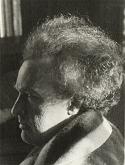
William Gray Purcell
circa 1930s
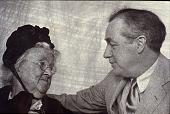
Catherine Garns Gray and
William Gray Purcell, in their last photograph together
circa 1928
A few personal relationships that originated in the Portland decade helped to
sustain Purcell through these difficult years. Douglas Donaldson drove from Los
Angeles for weekend visits, and Purcell remembered his friends at the Oregon
Society of Artists by funding an exhibition contest. James Van Evera Bailey, who
could not find work in the Pacific Northwest, arrived in California to construct
houses built by Purcell as guest cottages or rental properties in Banning and
nearby Palm Springs. Even in his incapacitated state, Purcell kept alive his
interest in the practical problems of architecture by developing his
understanding of structural techniques.

Front view, 1981"Banning Cottage"
Speculative house
also known as "731P"
Banning, California 1932
James Van Evera Bailey, associate architect

Garage wing, 1981
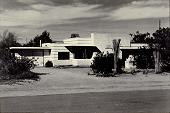 |
Speculative house Palm Springs, California 1932 James Van Evera Bailey, associate architect |
 |
Being remodelled, 1981 |
The design of a
rental property in Palm Springs featured a horizontal
brick-and-board wall treatment that emphasized the flat character of the desert
landscape. Eaves extending several feet beyond the walls contained baffled louvres that aided even the slightest breeze to enter the interior. The house
also had an attached garage. Several similar designs were sketched for an
intended group of speculative houses, and Bailey applied the same principles to
other small houses in an architectural practice that he carried on in the area.
Although Purcell continued to contribute occasional pieces for publication, his
writings became limited to a carefully observed ration of correspondence and
terse daily dairy entries as these years progressed. In the small, leather
pocketbooks in which he wrote, Purcell kept a meticulous record of the progress
of his disease, notes on the affairs of visitors, and the efforts to obtain his
divorce. For a man given to an active life as Purcell had always been, the
Banning years of forced rest were psychologically depressing.
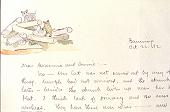 |
Detail, letter from William Gray
Purcell to Catherine Garns Gray and Annie Ziegler October 22, 1932 |
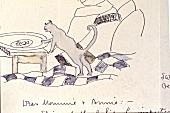 |
Detail, letter from William Gray
Purcell to Catherine Garns Gray and Annie Ziegler circa 1932 |
To keep himself occupied, Purcell began to decorate letters written to Catherine
Gray and her companion Annie Ziegler with watercolor sketches showing the lives
of a group of cats that wandered in and out of his room. When he could go
outside, he developed his technique by sketching flowers and the desert
vegetation. As his stay at the sanatorium grew longer and the course of his
illness showed a recurring pattern, the watercolor sketches became very small,
moody, and abstract while accumulating in great numbers.
One redeeming event to come from his time in the sanatorium was meeting Cecily
OBrien, an Englishwoman who actually suffered from a misdiagnosed case of
emphysema. On those days when the doctor permitted a hundred-foot walk, Purcell
went down the hall to read or eat lunch with Cecily. When possible, they shared
time sitting in the sanatorium gardens. Shortly after his divorce from Edna
Purcell became final in late 1935, Cecily O'Brien and Purcell married. Following
a risky operation that restored Purcell to somewhat better health, the couple
left the desert for a country estate in the Pasadena foothills near Los Angeles.
